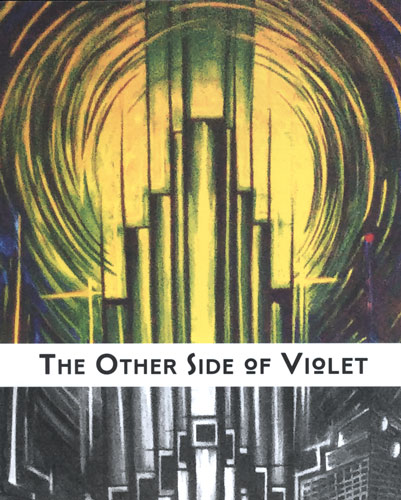The Other Side of Violet

Jane Ormerod, Thomas Fucaloro, David Lawton, George Wallace, Aimee Herman, Mary McLaughlin Slechta
August 2017
Valerie Wieland
I figure most people who read book reviews are also writers. So let’s dig right into David Lawton’s interview with Pulitzer Prize winner Paul Harding, featured in a new anthology called The Other Side of Violet. Harding endured rejections with his first novel, Tinkers, but five years later it was published by a literary press. He was teaching at the time and happened to look online to see who won the Pulitzer. “Honestly, I sort of half fainted—‘swooned’ would not be inaccurate—onto the floor of the crummy grad student apartment I was staying in. Totally surreal,” he says.
I figure most people who read book reviews are also writers. So let’s dig right into David Lawton’s interview with Pulitzer Prize winner Paul Harding, featured in a new anthology called The Other Side of Violet. Harding endured rejections with his first novel, Tinkers, but five years later it was published by a literary press. He was teaching at the time and happened to look online to see who won the Pulitzer. “Honestly, I sort of half fainted—‘swooned’ would not be inaccurate—onto the floor of the crummy grad student apartment I was staying in. Totally surreal,” he says.
Harding then draws on his music background to say, “I write by intuition, at least at the first draft stage. I still write very rhythmically. I hear sentences as measures of rhythm—so many ‘beats,’ so many syllables, at such a tempo, with such dynamics, and so forth.” Giving hope to fellow writers, he adds that “There are people out there [ . . . ] who want and search high and low for art.”
Such expressions of art naturally vary widely through The Other Side of Violet. For example, there’s a whole lot of sex going on in this anthology, and you’ll have no trouble finding it on your own. Instead, I’ll point out a few other ways writers express themselves.
The other interviewee in this book, poet and novelist Tim Z. Hernandez, contributes a poem titled “Brown Christ”:
Yesterday, I saw God,
a brown Christ hovering
above an onion field
over tilled plains of the San Joaquin—
frayed constellation of denim,
ox hide work boot broken at the heel,
Follow that with “To the People Who Say I Look Like Jesus:” by Troy Kody Cunio, which follows a similar theme of seeing God or Jesus in someone else:
No, I don’t.
I look like a thrift store painting of Jesus.
I am
discount devotional.
[ . . . ] When I was living in cars and on strange mattresses,
when this beard was from neglect and not choice,
before this year of full belly,
[ . . . ] maybe then
I looked a little bit like Jesus.
Babies are on the minds of several writers, each of them tackling the subject in a unique way. “Geography of the Changing Body: Hands,” by E.J. Antonio, maps an entire life in one richly-textured paragraph that begins:
Say small pudgy smooth skin; say these are good for exploring the human face; say how the thumb finds the mouth to sooth the panic of being too small in a place too big; [ . . . ] just say everything tastes better when mixed with moistness from skin and random germs from the highchair tray.
Martha Clarkson, in “At the 5-Way Intersection on the Drive Home from the Obstetrician, Learning the Baby is Down Syndrome,” constructs this narrative:
I am stopped by red lights
our new baby-car van
lying in shadow
of a rumbling cement truck
[ . . . ] the cab man smoking
plaid elbow out the window
pulls away with the clear-throat
of changing gears
pulls away to rebar fields to deliver
healthy concrete babies.
Whereas, Mark Blickley’s take on babyhood is depicted in “Meconium Aspirations: A Play in Ten Breaths” with the only actor being BABY. In one of those breaths, reminiscent of Stewie on the TV show Family Guy, BABY utters:
I know, I know, you’re thinking how the hell can a newborn be offering up journalistic observations, historical veracities, and judgmental insights? I can’t answer that question, but I am leaning towards a belief in some sort of reincarnation. Maybe I’m the next Dali Lama.
When it comes to mastering writing styles, Carol Guess has composed a piece with wonderful rhythm and flow. She calls it “Ten Perspectives on a Smoking Gun.” Here’s some of the fifth perspective:
You came back in a storm, but it wasn’t a storm, and it wasn’t you when I looked through the peephole. First peephole, then peepshow, then delivery pizza. Another knock: not you again. When you come back, it’s roses, but I’m allergic to roses. When you come back, it’s you, but I can’t tell if it’s me.
Another champion at rhythm and flow is Chet Corey with these lines from his prose poem “The Double”:
I am the ambiguity in the double entendre of the life you lead, the indelicate meant between your said and unsaid. I am the double shot of disbelief and belief you pour yourself straight up and drink in a gulp. I am the double agent who sells secrets to both sides in your quarrel with yourself.
Read The Other Side of Violet to discover seasoned writers and new literary energizers. They’re not only a great read, but their submissions just might revitalize your own writing skills.




